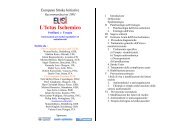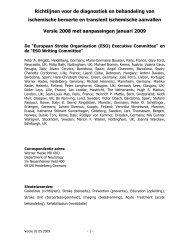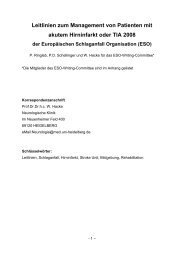Guidelines for Management of Ischaemic Stroke 2008 - ESO
Guidelines for Management of Ischaemic Stroke 2008 - ESO
Guidelines for Management of Ischaemic Stroke 2008 - ESO
Create successful ePaper yourself
Turn your PDF publications into a flip-book with our unique Google optimized e-Paper software.
<strong>ESO</strong>-<strong>Guidelines</strong> <strong>for</strong> <strong>Management</strong> <strong>of</strong> <strong>Ischaemic</strong> <strong>Stroke</strong> <strong>2008</strong><br />
Some centres prefer to use MRI as first line routine investigation <strong>for</strong> acute stroke.<br />
MRI with diffusion-weighted imaging (DWI) has the advantage <strong>of</strong> higher sensitivity <strong>for</strong><br />
early ischaemic changes than CT [130]. This higher sensitivity is particularly useful in<br />
the diagnosis <strong>of</strong> posterior circulation stroke and lacunar or small cortical infarctions.<br />
MRI can also detect small and old haemorrhages <strong>for</strong> a prolonged period with T2*<br />
(gradient echo) sequences [143]. However, DWI can be negative in patients with<br />
definite stroke [144].<br />
Restricted diffusion on DWI, measured by the apparent diffusion coefficient (ADC), is<br />
not 100% specific <strong>for</strong> ischaemic brain damage. Although abnormal tissue on DWI<br />
<strong>of</strong>ten proceeds to infarction it can recover, which indicates that DWI does not show<br />
only permanently damaged tissue [145, 146]. Tissue with only modestly reduced<br />
ADC values may be permanently damaged; there is as yet no reliable ADC threshold<br />
to differentiate dead from still viable tissue [147, 148]. Other MRI sequences (T2,<br />
FLAIR, T1) are less sensitive in the early detection <strong>of</strong> ischaemic brain damage.<br />
MRI is particularly important in acute stroke patients with unusual presentations,<br />
stroke varieties, and uncommon aetiologies, or in whom a stroke mimic is suspected<br />
but not clarified on CT. If arterial dissection is suspected, MRI <strong>of</strong> the neck with fat<br />
suppressed T1-weighted sequences is required to detect intramural haematoma.<br />
MRI is less suited <strong>for</strong> agitated patients or <strong>for</strong> those who may vomit and aspirate. If<br />
necessary, emergency life support should be continued while the patient is being<br />
imaged, as patients (especially those with severe stroke) may become hypoxic while<br />
supine during imaging [124]. The risk <strong>of</strong> aspiration is increased in the substantial<br />
proportion <strong>of</strong> patients who are unable to protect their airway.<br />
Perfusion imaging with CT or MRI and angiography may be used in selected patients<br />
with ischaemic stroke (e.g. unclear time window, late admission) to aid the decision<br />
on whether to use thrombolysis, although there is no clear evidence that patients with<br />
- 22 -





